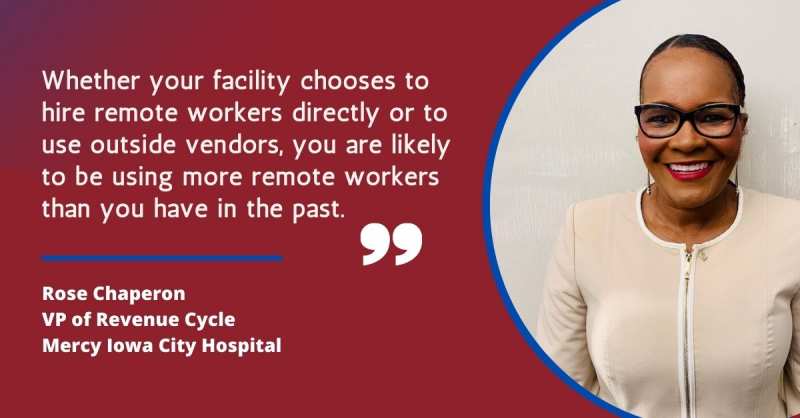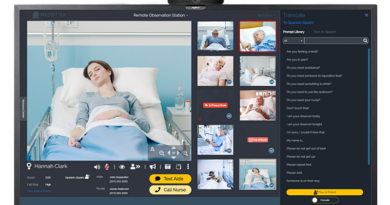Covid-19, Remote Workers, and Technology in 2020 and Beyond
By Rose Chaperon, Ph.D., MSHL, HLRM, Vice President of Revenue Cycle, Mercy Iowa City Hospital
Having worked in many different environments over the years, from remote, critical access, Indian health, and large suburban hospitals, I have seen how technology has evolved in the past two decades. These technological changes have advanced the usage of remote workers and services. While progress towards improved technology has facilitated an ever-increasing trend of using remote resources both locally and globally, this year the Coronavirus has dramatically accelerated adoption of this practice, bringing this business model out of extended infancy and into a mainstream method of managing business processes and human resources almost overnight.
There have been many reasons to use remote workers for the past decade and more, including limited availability of local talent in rural communities, and the cost and time savings of not having to provide office space for certain types of workers such as Medical Billers, Coders, Collectors, and Registration personnel. The key qualifying factor in determining if an employee would qualify for as a remote worker was, “do they need to be onsite to perform their job functions.” Historically, in rural areas until recently, one of the big obstacles to moving forward in this trend has been limited technology, primarily limitations in high-speed internet. This shortcoming has been even more challenging for the hospitals that wanted to leverage a work from home strategy as hospitals and vendors have had higher speed internet for multiple years now, but rural employees have not. However, the onset of Covid-19 and the strong desire to social distance, combined with the maturation of increased rural high-speed internet services, has driven the Remote worker trend to blossom and even explode in rural hospitals across the country.
A big decision for hospitals now is whether to leverage vendor relationships or to expand their own local staff understanding; the information technology (IT) lift and additional resources to set them up as a remote worker can be significant. Whether your facility chooses to hire remote workers directly or to use outside vendors, you are likely to be using more remote workers than you have in the past. There are some of the pros and cons associated with either of these choices.
Vendors can provide remote workers that might be 2,000 miles or more away from the facility. These workers are often able to perform requested functions as well as if they were working on site. A key operational component when determining success for remote workers is the training a client partner is willing to provide. An organization’s ability to communicate facility guidelines, workflows, policies, and procedures can drastically impact a vendor’s level of success. Using vendors can provide cost savings, ease of resource management, and speed when providing new hires or replacing workers. In addition, ramping up staff levels for initiatives such as computer or system conversions can offer opportunities for vendors to add resources and positively impact an organization. Vendors can often supply a well-qualified employee in as little as a few hours when the Human Resources (HR) department might need a few weeks or even longer to find the same caliber candidate in the local market. Often, the Vendor contractors have years of experience and need little to no training on their proprietary systems and are adept at learning new systems quickly. Quality vendors are also versed in background checking and credential verification of the types of employees that they specialize in, and are better networked to source talent and identify potential employee red flags in the job market.
Using outside vendors makes sense for many, especially when talking about small teams of specialized types of workers, such as medical coders, billers, and accounts follow-up representatives.
In-house control of hiring standards and personnel is certainly a strong reason to keep the HR department directly involved in the remote hiring processes, but that also includes the costs associated with hiring W2 employees and liabilities that go with that. In many locations, it can be difficult for a hospital’s HR department to find local talent, and equally challenging to figure out where and how to reach workers with job opportunities on a more regional or national level. While vendors have their benefits, some can be unscrupulous with poor performance, so keep an eye on their performance, invoicing, and KPI. Some vendors have been found to be using unapproved and uncredentialed offshore resources, instead of saving the organization money; this has the potential of causing millions in losses.
Some executives see vendor usage as being more expensive than direct hiring. Still, when looking at the whole picture, vendors can have a dramatic improvement on the bottom line and in the aggregate, be much more cost-effective for the facility. If an organization looks at the HR cost of an employee (the hourly plus cost to employ, plus an average of 25-30% for fringe benefits), vendors can seem expensive. But especially in remote areas, the higher caliber of talent available on a national level, and the better results in KPI performance that comes with a quality vendor, combined with the other issues already mentioned (access to talent, ease of replacement, time to fill, etc.), in the grand scheme using vendors to manage remote workers can be a cost-effective option.
In closing, there are options and decisions that we all need to explore in this “new normal” work environment. One of those is the choice between direct hiring and then managing the remote working staff or contracting with outside firms to provide those services.



